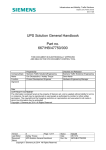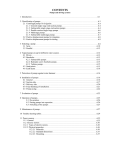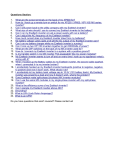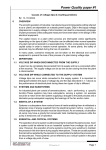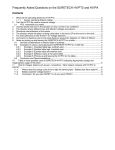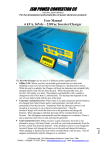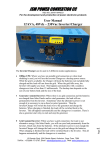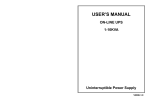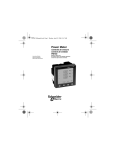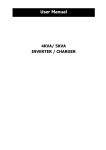Download Uninterrupted Power Supply (UPS) Primer
Transcript
Uninterrupted Power Supply (UPS) Primer by Martin Sims ([email protected]) Why use a UPS? Radio stations and studios require a source of electrical power to operate. This is usually the “mains supply” sold by Eskom or the local municipality that comes from the plugs on the wall. Many studios experience instances where this power supply is unreliable. When the power supply fails the studio is not able to do any work. To prevent this power protection or back-up equipment is needed. This is the purpose of an uninterrupted power supply (UPS). An UPS provides uninterrupted power to the station when the mains supply fails. There are many different UPS systems that supply different degrees of back-up protection. The choice of system for your studio should be made after considering the quality of the power supply in your area. For example stations located in areas that suffer from constant power disturbances would need a more complete power back-up system than stations located in areas where the power supply is very stable. But what are power disturbances? There are several kinds of power line disturbances that affect the mains supply. The mains supply is meant to be a stable AC. voltage of 230 volts at 50Hz. Lightning, power network switching and the operation of other high power equipment in your building such as elevators, spot welders and so on causes “spikes” in the mains voltage. A power surge or spike is when the mains voltage jumps over 230 volts for a period of time. This condition is associated with equipment damage. Computers and sensitive digital audio equipment is frequently “blown” when not protected from power surges. The mains voltage can also can dip below 230V providing an undervoltage supply. This kind of condition is often seen in light bulbs that dim in intensity. The mains supply can also be “noisy” when signals at frequencies other than 50Hz find there onto the power lines. Finally the supply can black out. In this case there is a total voltage loss and all electrical equipment is left without power. Blackouts can last a few moments or sometimes days. A stable power supply is needed for the smooth and safe operation of your equipment. This is what an appropriate UPS should provide. An UPS counters power disturbances by fulfilling two functions. Firstly a UPS acts as a buffer between the power sensitive equipment and the fluctuating mains power supply, providing protection from power surges, dips and line noise. Secondly, a UPS provides back-up power in the event of a complete power failure. The duration of the availability of back-up power is dependent on the capacity of the UPS battery. A generator can also be included to provide back-up power for extended periods. Different Types of UPS There are three main types of UPS: the off-line, line interactive and online UPS. Each one has different features: The Off-Line UPS Off-line or standby UPSs are those power systems where equipment is normally supplied directly from the mains supply. The offline UPS only supplies the equipment when the mains supply is not available. These systems are intended for equipment that can tolerate the momentary loss of power while the system switches to back-up power. They provide no protection from surges or dips in mains voltage. The diagram shows a battery system used to provide back up power. The inverter shown in the diagram is a device that converts the direct current (DC) supplied by the battery to the alternating current (AC) that is needed by equipment. Instead of a battery a generator could be used in the same way. This kind of system would be best in areas with minimal power problems. The Line Interactive UPS Line-interactive or single conversion UPSs are used when mains voltage fluctuations are a problem. In the lineinteractive system the mains supply is fed directly to the equipment through an inductor or transformer. Switching elements in combination with the inverter, monitor the mains supply to control the supply to the equipment. The name “line-interactive UPS" comes from the fact that the inverter interacts with the mains line to drop, boost, or replace AC power as needed to maintain voltage control. These UPSs are cost effective but still expose equipment to short power fluctuations while switching happens. able to give you detailed information on the nature of power disturbances in your area. This information would help you to make the best decision on a UPS. Hospitals, police stations and other emergency services in your area are also likely to make use of UPS systems. Contacting them and hearing their experiences will put you in a position to make a better UPS decision. Generator The On-line UPS The on-line UPS provides the highest level of power protection as the equipment is always powered by the UPS and not the mains supply. The on-line UPS is also called a double conversion on-line UPS, as input power is converted twice first to DC using a rectifier. This eliminates any surges or dips and line noise. And then an inverter converts the DC into a continuous, completely re-conditioned AC supply. In the event of a complete mains blackout the inverter draws DC power from the UPS batteries. This is also the case with the line interactive UPS. On-line UPSs are the most expensive. UPS Specifications Once your station has settled on the type of UPS to use there are two more specifications that have to be decided. Firstly a power rating usually specified in kilovolt-amperes (kVA). This is determined by the power requirements of your equipment. Each piece of equipment you intend to protect using an UPS draws a certain amount of power. By measuring the power consumption of all your equipment you can find out how much power an UPS must be able to supply to keep all the equipment running. This is usually a task left to your UPS supplier or electrician, although a good estimate would be that about 1kVA of UPS power is needed for each studio. This figure excludes back-up power for lights and transmission equipment. A second specification is the duration of back-up power that the UPS batteries can supply. This specification greatly influences the size and cost of the UPS. Different batteries can supply a few minutes up to a few hours of back-up power. Stations in areas where the power supply is often lost for long periods might choose to have a short period of battery power and have a generator connected to the system to provide back-up for long periods. The batteries then only need to provide enough back-up time to start or refuel the generator. Stations in areas where blackouts happen often but do not last for very long might not be able to justify the expense of a generator but would still like a reasonable amount of back-up so they may choose a system with a few hours of battery power. It is useful to consult with your local council’s electrical department on this issue. They should be A generator is a petrol or diesel driven engine that produces electricity. Generators are used to supplement the battery power of an UPS or can be used as the sole source of backup power in an off-line system. If a generator is used on its own in an off-line system the station will be without power for the time it takes to get the generator running. Modern backup generators used to supply several kVA of power to a studio are generally small and relatively portable. Owning a generator however presents several additional responsibilities. Firstly because of the danger from exhaust fumes generators can not be run indoors. This means building an exterior enclosure for the generator. Secondly a generator is an engine and like a car engine it needs regularly use and servicing to stay in good working order. Thirdly a generator presents a safety hazard. Improper use or installation of a generator can cause property damage, serious injury and even death. The installation of a generator needs to be handled by a suitably qualified professional. Installation of a generator may need special permission or procedures to comply with building codes and lease agreements. The presence of a generator on your property can also have insurance implications. If your station uses a generator read and follow the operating and safety instructions contained in the user manual to protect yourself, and your studio or radio station.





